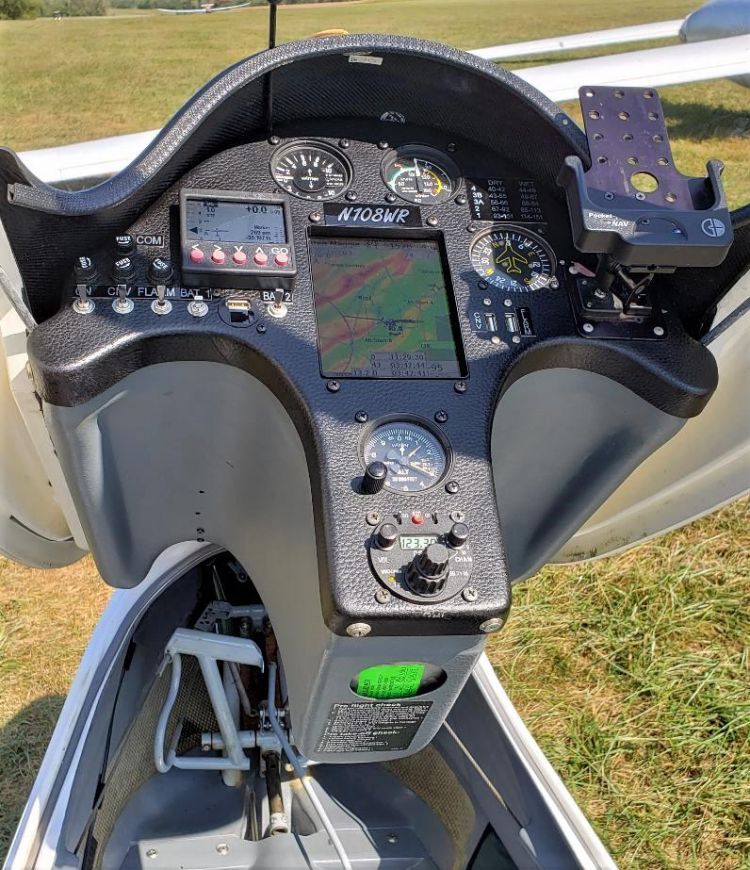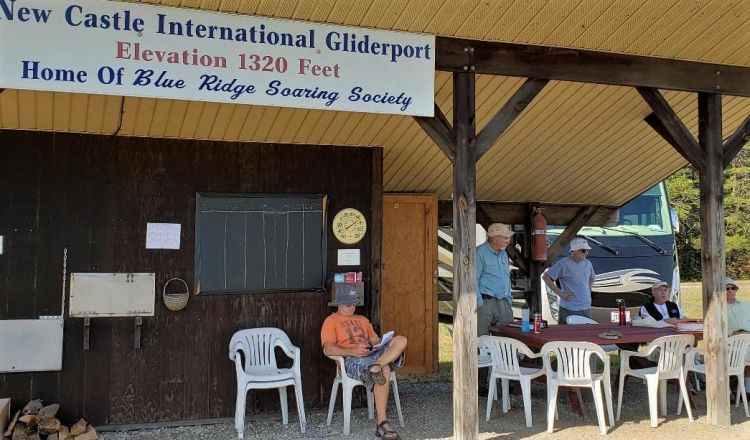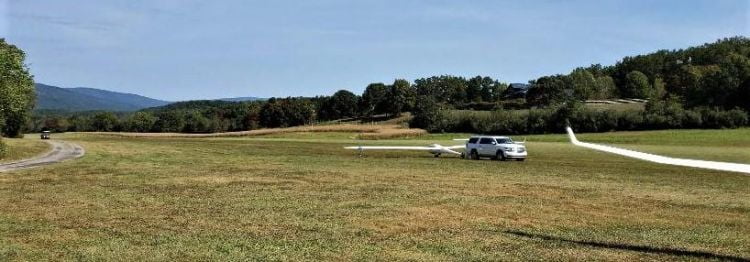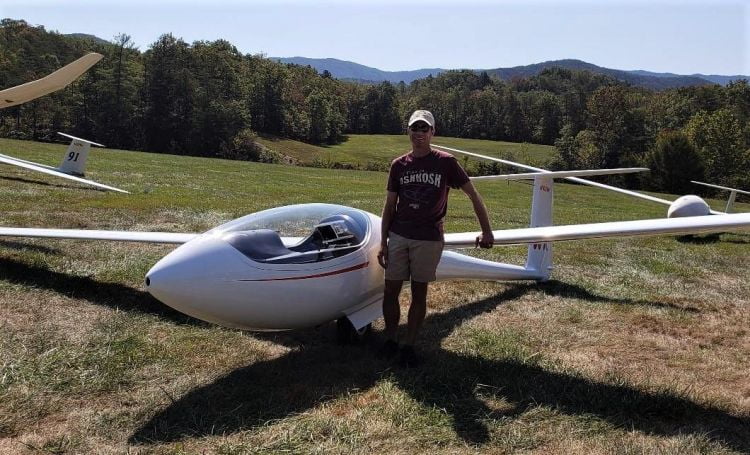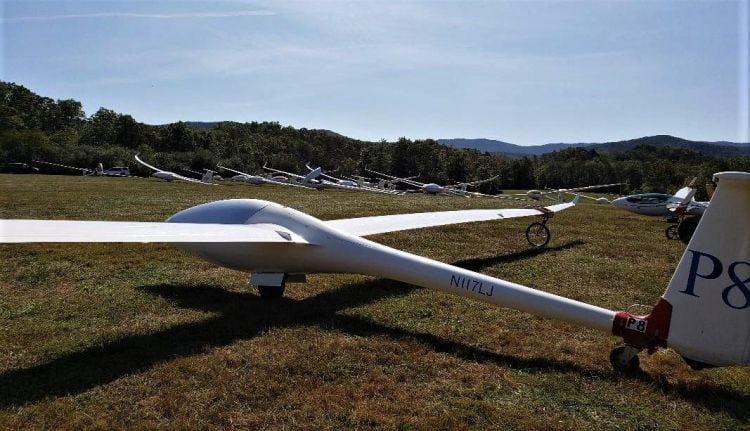Pam Dudding
Contributing writer
For residents in Craig County, seeing gliders in the sky is a common scene, coming from the New Castle International Gliderport (NCIG).
This year the Blue Ridge Soaring Club had 21 pilots to enter their annual ‘Region Four South’ flying competition, sanctioned by the Soaring Society of America (SSA) and held September 16 through September 21.
As pilots from across the United States started arriving, many were happy to see familiar faces, from California, Florida, Texas and Canada, just to name a few.
“I have been coming here for 36 years in a row,” pilot Hank Nixon shared. “I came here first in 1984, from northern New Jersey. I’ve been flying competition for 42 years. This is the best party in ‘soaring’ that there is.”
He added, laughing, “It’s like a family reunion every fall and we just happen to bring the gliders which just complicate the experience.”
The competition is based on the best speed around a prescribed course.
“It’s a fun sport and very interesting!” Jim Cole, the Blue Ridge Soaring Society (BRSS) President Cole explained. “I’ve been a member of this club since the early 60’s as my dad, George Cole, was one of the founding members of the club.”
“It is not only very technical in some respects, but it is also even more cerebral and some of these guys are really good. You have to have a lot of experience in figuring out what is going on; the weather, how and where they should go, how fast they should fly and always monitoring the winds.”
The instrumentation has advanced tremendously in the last several years.
“The cockpit now has a modern computer which contains the needed navigational information, including their average climb, what the current speed is, and they have calculators that tell them how much altitude they need to get back to this airport,” Cole said.
He also noted that all of the scoring is done off the instrumentation of the GPS, which is on each plane and logging the entire time.
“When they return from a task, each pilot sends their information to the scorer via email, who is actually in Pennsylvania, who runs them through a scoring program,” Cole explained.
When the pilots and Cole were asked if anyone flew ‘old school’ without computer navigation, they all laughed, shaking their heads no. Cole added, “Back then, you had to take pictures of the turn points to prove that you had been there.”
On Friday morning, Cole shared that they were on day five of the competition.
“Monday was a really good day as the thermals were really good, over 9000 feet. Not only is it beautiful but it relaxes the pilot a lot. When you get nice and high, you can pretty much go anywhere you want to. Distances were about 200 miles and the speeds were in the 65mph average speed.”
Tuesday was a “pretty good” day, with distances just over 100 miles and the speeds were lower.
Sadly, they didn’t fly on Wednesday. “The weather was not forecast to be good, and actually started getting worse and we called it off about 10:30,” Cole said.
Thursday was a good day for the pilots with speeds in the mid 60’s and distances were 135 miles.
Friday morning, the usual check was conducted. They send up one sail plane around 12:30 to look at the condition and to see what kind of ‘climb rate’ is attainable.
“He will report back down to us and depending upon what the report is, we will launch early as 12:45 but it could be as late as 2pm,” Cole noted. There were three tasks to choose from. The first was a three hour and then the other two were the same task but allow only two and a half hours or an hour and a half.
In the competition, the pilots do not want to come back early, as they are required to fly their task time or a little longer, or points are taken away.
Friday’s task was to Union WV, then Ingles Field above the Homestead on top of the mountain where an airport is, then to Blacksburg, Eagle Rock and back to New Castle.
“When we looked at the weather forecast at the different sights this morning, there was a big variation from what you saw at the different sites,” Cole explained. “A lot of it relates to the maximum temperature which is really important as temperature triggers thermals. Without high enough temperatures, you don’t get the thermals triggered, and they don’t go as high.”
“Yes, these are all gliders with no engines; It is unbelievable!” Cole exclaimed.
There were pilots from Houston Texas who just drove up to New Castle to fly in the contest, even though there are many other contests throughout the U.S.
“Part of the reason so many travel this far to New Castle, is because they love this area,” Cole said smiling. “It has a different flying terrain than anywhere, in fact it’s one of the most beautiful places to fly in the country.”
He added, “It can also be one of the more challenging places as well. They like that and this is such a beautiful farm that we get people coming back every year, some for over 30 years.”
Forty three year old Jared Granzow from Columbus, Ohio was one of the younger pilots and his first contest in flying as he is used to only flying cross country flights in his 2002 Schleicher SW-27.
“As a little kid, I always wanted to fly and took lessons at the local airport right out of high school,” he said. “I’ve been flying all my life but just got into gliders about seven years ago just for a hobby.”
He added that he had fun all week thus far. “It’s a race here but you also get to see some gorgeous scenery. This is an awesome club for the local people. They should take advantage of this, as there’s not that many around the country. They have an awesome facility and a lot of good comradery with good events.”
Dan MacMonagle has been flying about nine years, starting with hang gliders for ten years and graduated to the gliders.
“This is my fourth year coming down here from Boston,” he said. “This is a great bunch of people down here. A friend from my club up in Vermont dragged me down here as he had been coming here for quite a while. We have had a great week and have only missed one day so far with the weather. Last year the weather was a bummer and we missed all six days. This Club is so much fun; it defines the club. They feed us every night and we have bon fires which is really cool.”
Some pilots had crew members. David Ridding, from Toronto Canada is the crew member for Tim wells that lives in New York. He also lived in that area for 13 years and they were members of the same club in Harris Hill Soaring.
“I do fly and have been flying for 25 years,” he shared. “A number of the pilots have a crew as we put the glider together, take it apart, clean it after flying, do safety checks and a bunch of different things, like go to the grocery store when we run out of food,” he added laughing. “The forecast and the actual weather haven’t really matched on some days, so the joke around here is that there is a many that runs a local garage is the weather oracle so today is supposed to be a good day.”
“The Blue Ridge Soaring Society runs a beautiful event here!” Hank Nixon shared. “They have a great facility and the hospitality is second to none! We have group meals every night that keeps everybody together, partly because when we started doing this, there weren’t any motels around. So, there were no options other than for us to come and stay here and camp. That generated this sense of community that keeps us all coming back every year; It’s a wonderful place.”
Nixon flies an ASG -29 which is an 18-meter glider with a wingspan of about 62 feet. “There are about 12 of us flying in that class,” he explained. “There is another class that is handicapped because of the variety of different gliders. The 18-meter gliders can go just a little faster.”
Adding, “I’m a member of the club here also. We’re going to get to fly five of the six days so that is really good.”
The weeks events ended on Saturday, and all of the pilots seemed to be happy with the time they were able to fly, as well as the comradery they experienced during the week.
Trophies were presented. In the 15 Meter – Standard Class, first place went to Karl Striediech from Port Matilda, PA and second place to Evan Ludeman from New Boston, NH. The 18 Meter Class first place winner was Hank Nixon from Wayne, NJ and second place to Robin Clark from St. Johns, FL.
Cole appreciated all who participated and encouraged everyone to return next year.



